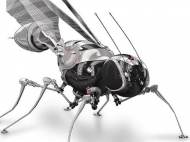Researchers observe flying insects to create smaller flying machines
 A group of researchers from the University of Oxford is developing small aerial vehicles with flapping wings inspired by those found on insects. The researchers envision that their insect-size vehicles will be suitable for many different purposes ranging from helping in emergency situations considered too dangerous for people to enter, to covert military surveillance missions.
A group of researchers from the University of Oxford is developing small aerial vehicles with flapping wings inspired by those found on insects. The researchers envision that their insect-size vehicles will be suitable for many different purposes ranging from helping in emergency situations considered too dangerous for people to enter, to covert military surveillance missions.
“Nature has solved the problem of how to design miniature flying machines”, said lead researcher Dr Richard Bomphrey, from the University of Oxford Department of Zoology. “By learning those lessons, our findings will make it possible to aerodynamically engineer a new breed of surveillance vehicles that, because they’re as small as insects and also fly like them, completely blend into their surroundings.”
The incorporation of flapping wings is the secret to making the new designs so small. To achieve flight, any object requires a combination of thrust and lift. In manmade aircraft, two separate devices are needed to generate these (i.e. engines provide thrust and wings provide lift), this limits the scope for miniaturizing flying machines. But an insect’s flapping wings combine both thrust and lift. If manmade vehicles could emulate this more efficient approach, it would be possible to scale down flying machines to much smaller dimensions than is currently possible.
“This will require a much more detailed understanding than we currently have of how insect wings have evolved, and specifically of how different types of insect wing have evolved for different purposes”, said Bomphrey. “For instance, bees are load-lifters, a predator such as a dragonfly is fast and maneuverable, and creatures like locusts have to range over vast distances. Investigating the differences between insect wing designs is a key focus of our work. These ecological differences have led to a variety of wing designs depending on the task needing to be performed. It means that new vehicles could be customized to suit particular uses ranging from exploring hostile terrain, collapsed buildings or chemical spills to providing enhanced TV coverage of sports and other events”.
Supported by the Engineering and Physical Sciences Research Council, Bomphrey and his team use both cutting-edge computer modeling capabilities and the latest high-speed, high-resolution camera technology to investigate insect wing design and performance. By placing insects in a wind tunnel, seeding the air with a light fog and illuminating the particles with pulsing laser light (using a technique called Particle Image Velocimetry) the researchers observe the air flow velocities around insect wings.
“Evolution hasn’t settled on a single type of insect wing design”, said Bomphrey. “We aim to understand how natural selection led to this situation. But we also want to explore how manmade vehicles could transcend the constraints imposed by nature.”
The research is expected to produce findings that can be utilized by the defense industry within 3 to 5 years, leading to the development and deployment of insect-sized flying machines equipped with micro-cameras and other surveillance equipment within 20 years.









Excellent case of biomimicry. Infact Aeroplane was built besed on the technoilogy how birds fly.
Dr.A.Jagadeesh Nellore(AP),India
E-mail: anumakonda.jagadeesh@gmail.com